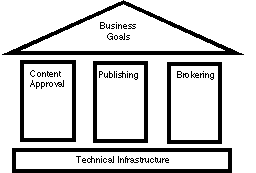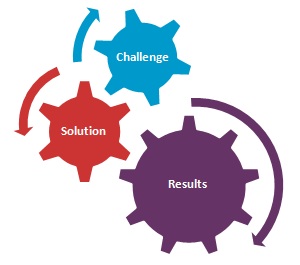When you came to work today, you most likely started your computer and eventually made your way to your organization’s intranet. If you were lucky, you found an intuitive interface that provided access to the information you need to do your work and a guided path to the web applications your firm has implemented to support the practice of law. We take all of this for granted in 2007 and usually expect more than what we have. When and how did the intranet come in to being and what does the future hold for this very useful technology. What will the next generation intranet look like?
Depending on what articles you read, intranets introduced in 1993 or 1994. Steven L. Telleen, working at Amdahl, first coined the term “intranet” in July 1994. In the first iteration of intranets, the focus was on creating a universal client that provided access to information across a variety of platforms. At the same time, the development of an intranet was intended to be an alignment of technology and business goals as demonstrated in Figure 1 published in Telleen’s early writings.

Figure 1
As Telleen was working on what the framework of an intranet should look like, Netscape was working on the web browser with Microsoft hot on their heels. The developer of the Mosaic browser, Marc Andreessen, reported that even as he developed the browser, he was hearing from businesses who were interested in using the browser for internal purposes McCartney, L., “Intranet Business Follows Race for Cyberspace”, Upside, Dec 1996).
Following the introduction of the browser, Netscape and then Microsoft introduced their intranet server suites (Netscape Server Suite and Microsoft Back Office) that could be used to create a web environment within an organization. With the infrastructure in place for creating intranets, it would seem that the first generation intranet would be an integrated marvel.
Instead, most companies and firms who put intranets in place used little integration of disparate systems, usually due to a lack of commitment in resources (skills & dollars). Intranets were most often developed with static pages that required updating by individuals who knew html.
Additionally, many companies had no standards or guidelines for what was added to the intranet and often the sites that were built were collections of unused documents that were poorly organized. The first generation was a good start, but the early adopters in law firms soon learned that they needed more than they had.
The second-generation intranet brought more integration with firm resources. Using portal products like Plumtree, LawPort, SharePoint many firms developed intranets that pulled content from firm databases and put it in context. An example would be the development of client pages where content would be pulled from a firm’s accounting and document management systems or any other system that held client information.
During this phase of development, more applications became web based and were accessed from the intranet. The development of RSS allowed news to be integrated as well. Some firms made huge investments in their intranets and they saw benefits for the dollars spent. Client/Matter centric intranets started to be developed.
Fast forward to today where many firms are starting to look towards the next generation of intranets. As the technology continues to develop, we are seeing new tools that make the development of a robust and feature rich intranet more attainable, even by smaller firms. Making the most of an intranet means paying attention to best practices.
Think of the intranet as a reflection of the business. The intranet has grown in purpose from an interface that allows access to a staff directory and policies and procedures, to the tool Telleen intended. Intranet strategy should be driven by the firm’s business goals and strategy.
Take time to plan. Installing SharePoint and throwing a portal together without taking time to plan will create problems. Get the right people to the table to discuss what the goals are for the intranet. Turn the goals into actionable steps with defined deliverables. Decide on a timeline and the development approach.
Do usability testing before, during and after the new intranet is developed. Success of an intranet hinges on content but also on how easy it is for your users to find what they are looking for. Along with the testing, survey and interview users to determine what needs have been met and what additional functionality is needed in the new intranet. You cannot overdo involving users in the planning.
Define requirements for the new intranet. What will it look like and what do you need it to do? Who will maintain content? How will they accomplish that task? If you are planning an intranet that is role based, what will each roll need when they open their browser? Do not get hung up on how the development will be done. Focus on functional requirements. The technical requirements will come later.
Define the architecture of the site and select the software needed to support the architecture. Will you use something like SharePoint? If so, are there web parts or third party solutions you should consider like LawPort, xmLaw, HubbardOne, or Handshake? What are other firms using? What do they consider their successes?
Develop a detailed project plan for the development phase. Depending on your goals, it may take weeks or years to develop the site. Create a plan that works for your unique needs. If you know you cannot accomplish all you want to do before you deliver the first version, divide the project into phases with version releases as you go from one phase to another.
Communicate with your users. The plan that will not work is one that does not involve the users of the intranet. “If you build it, they will come” does not always work. If you involve your users in the building process, they will be more likely to use what you have developed.
So what makes an intranet innovative? It probably depends on the firm but there are common threads. It is:
- Based on business needs and reflects the business
- Built using state of the art technology but not for technology’s sake – the technology meets a need whether you are using .NET, XML, RSS, web services, or other technologies that are becoming new standards.
- Integrates with other firm systems in a meaningful way – it puts content in context
- Provides customized and context based search at the point of need regardless of where one is on the site
- Empowers the content creators – consider using a content management system
- Empowers the users – give them what they need when they need it based on role, task, or other organizational structures
It is becoming clear that the next generation intranet is one that uses the latest in technology but goes many steps further if viewed as a tool to further business strategy. Firms are finding that their intranets can increase communication, make the business operate more smoothly and make them more competitive. Combine the technology with strategy and add good planning and you will have a platform for innovation for years to come.
This article was previously published in Practice Innovations, Oct 2006.

